First Drive: The 2025 Toyota Camry Is Ruthlessly Competent
Competency across the automotive industry is at an all-time high. Fast cars have never been faster. Efficient cars have never been more efficient. Trucks have never been truck-ier. And SUVs have never been more utilitarian. Mission briefs have been iterated and focused-grouped to an exacting endpoint, and consumers are the better for it. Despite that relative excellence across the board, a few nameplates have simply been doing “great” for longer. Within the midsize sedan segment, that descriptor may best be applied to the Toyota Camry.

Long the poster child for quiet, competent transportation, the Camry has never sparked the driving fanatic in us the way, say, the Mazda 6 did. Former editor-at-large Sam Smith described the previous, eighth-generation Camry as “beige excellence,” a damning accolade, but also, the more you thought about it, a noble one, too.
Toyota’s stalwart sedan, the king of its domain, is now in its ninth generation. Headlining the generation is a new drivetrain layout, the fifth-generation Toyota Hybrid System (THS 5) that will power all Camrys—the first time we’ve seen this model go entirely hybrid. Though it rides on the same TNGA-K platform as its predecessor, the Camry now sports new exterior and interior styling plus a host of tuning tweaks, some of which we’ll delve into later.
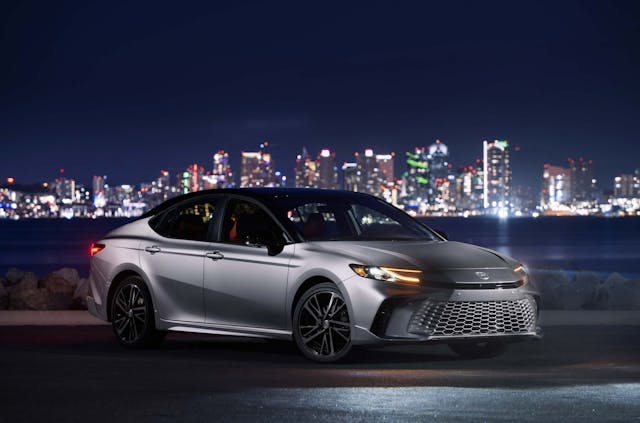
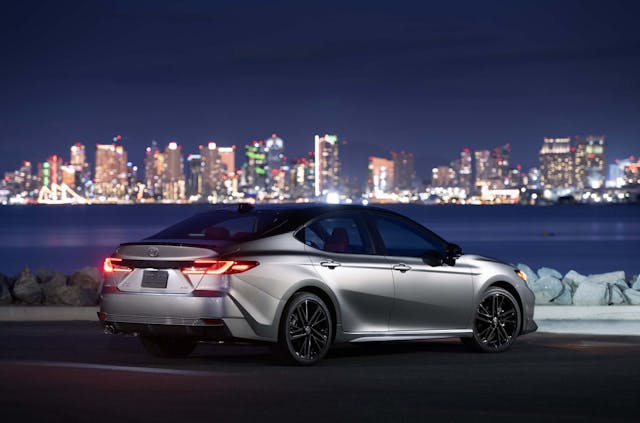
Specs: 2025 Toyota Camry XLE AWD
- Price: $36,020/$40,780 (Base/As-Tested)
- Powertrain: Hybrid 2.5-liter four-cylinder gas engine with three electric motors (two in the front, one on the rear axle)
- Combined Output: 232 hp
- Layout: All-wheel-drive, four-door, five-passenger sedan
- EPA Fuel Economy: 46 mpg city, 46 mpg highway, 46 mpg combined
- Competitors: Honda Accord Hybrid, Hyundai Sonata Hybrid
Toyota has simplified the trim lineup for the new car, now offering LE, SE, XLE, and XSE variants. While in San Diego to sample an array of Toyota products, we got to wheel the XLE and XSE. The two models represent higher-spec versions of the Camry’s core personalities—”luxury” with the XLE and “sport” with the XSE. The XLE rang the register for $40,780, while the XSE ran to $41,295.
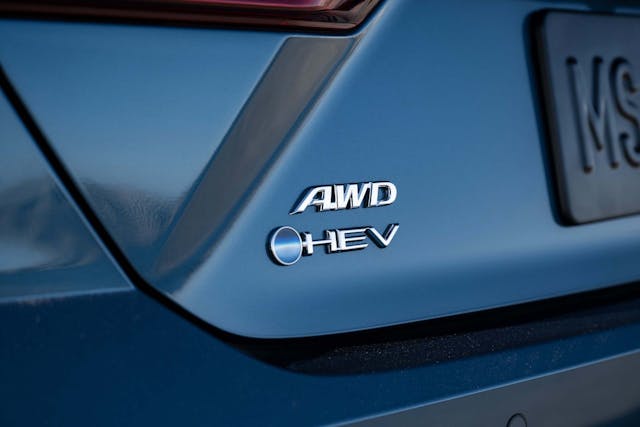
Toyota’s decision to make every Camry a hybrid feels significant but smart. The automaker has nearly three decades of hybrid experience that it has been able to apply to this fifth-generation system, which pairs a naturally aspirated 2.5-liter inline-four with a CVT transmission and two electric motors up front to offer 225 horsepower to front-wheel-drive Camrys.
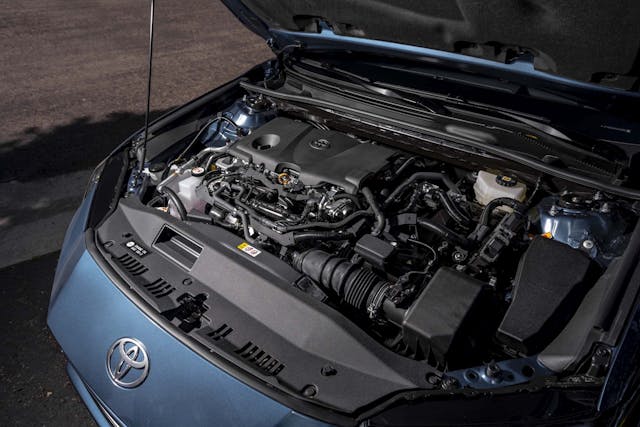
All Camrys will now also offer all-wheel-drive as an option, instead of siloing the feature into certain drivetrains, as Toyota did in the outgoing version—one of the benefits of simplifying from three engines (four-cylinder, six-cylinder, four-cylinder hybrid) down to one.
In the new AWD models, instead of a mechanical connection between the front and rear wheels, the all-wheel-drive system uses an additional electric motor on the rear axle that kicks on when extra traction is needed. AWD Camrys also get a slight bump in power, up to 232 hp. (Note: The additional output doesn’t come exclusively from that third electric motor; think of these hybrids as having a “pool of power” to draw from. The third motor, with the help of some technical tuning, makes the pool seven ponies larger.)
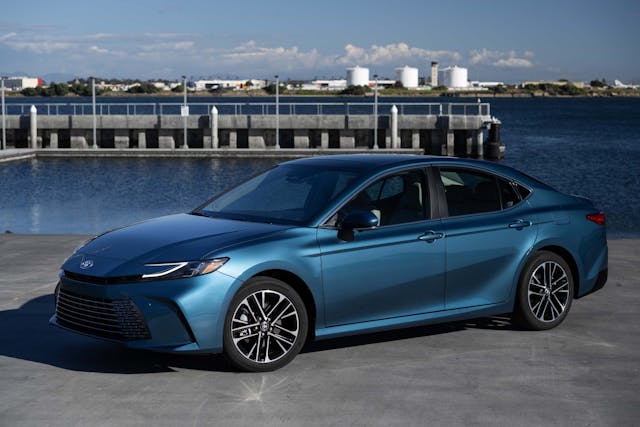
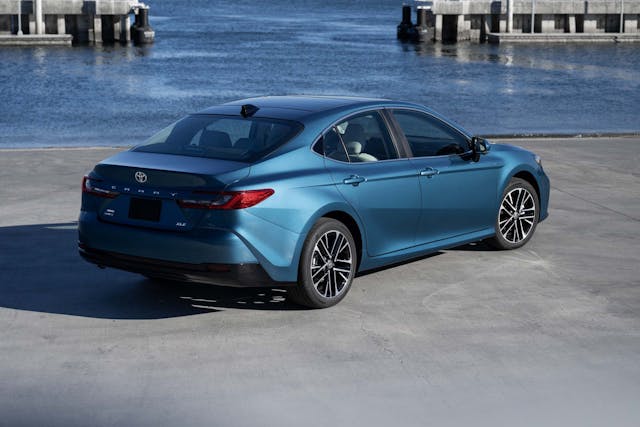
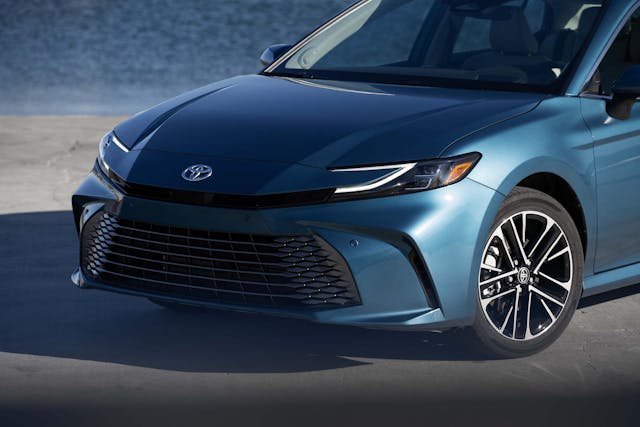
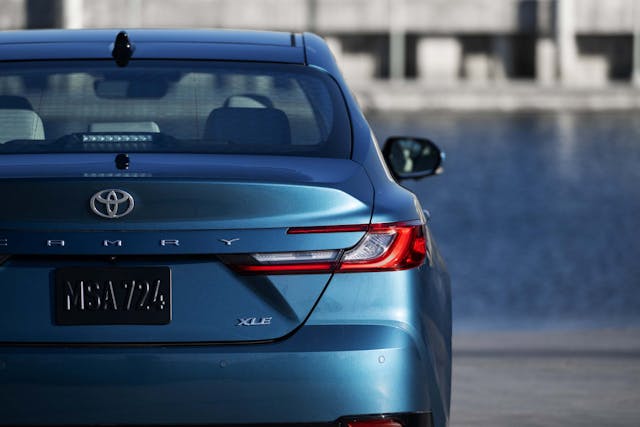
Technical jargon aside, know this: When you force all buyers into a hybrid drivetrain, your engineers then have to make the system feel as natural as possible. Hand-offs between gasoline and electric motors must feel almost imperceptible, as must the juggling act of switching from coasting regeneration to braking regeneration to actual brake pad application.
Dancing through this complex web of parameters is tricky, and Toyota’s engineers spent extra time on the feel of the braking system, adding an additional pump to the brake booster to help blur the line between regenerative braking and the natural feel of a pedal squeezing calipers. Though pedal feel is still a touch indirect, the handoff between regen and real squeeze is entirely invisible, something you can appreciate when crawling along in highway traffic on commutes.


Juggling the tasks of charging the battery, powering the wheels, turning on and off, and all the in-betweens has, in the past, been a real pitfall of most hybrids—even those from Toyota. Now, unless you’re searching for it, those switches happen almost entirely in the background. The four-cylinder and CVT pairing are still raspy when you boot it, but even that noise is more subdued than it used to be.
A little bit of music bumping through the XLE’s optional nine-speaker JBL audio system (part of a $4760 package that also netted a head-up display, vented front seats, a panoramic glass roof, and more) drowns any engine drone out entirely.

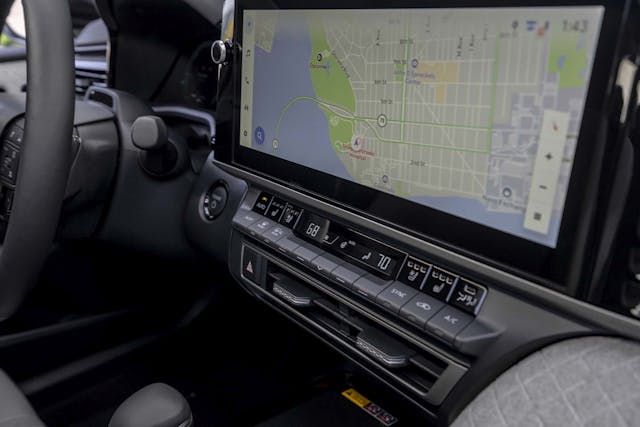
At which point you’ll reach the Camry’s zenith. This side of $80,000, no vehicle commutes as effortlessly. The quiet, remarkably efficient hybrid drivetrain returns between 44 and 51 mpg, depending on your configuration. The Camry XSE AWD, the least efficient model (44 mpg combined), manages to match the combined mpg rating of the 2024 Accord Hybrid Touring, even though the latter is front-wheel-drive only. The acoustic-laminated windshield and front-row windows seal out enough of the outside world’s dull roar to make drives feel additive, not diminishing.
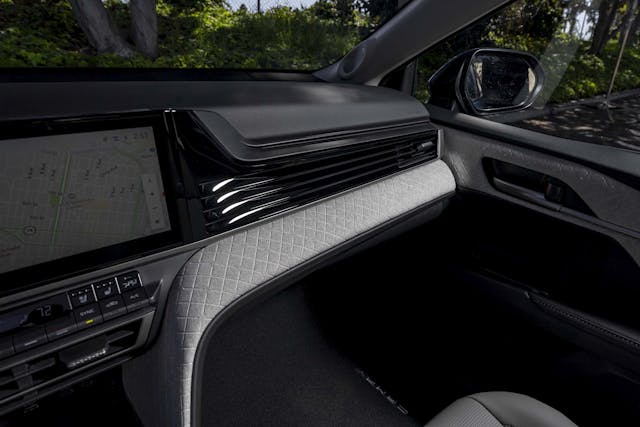
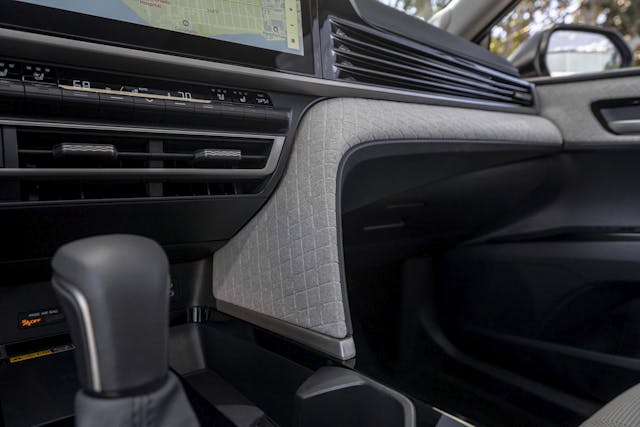
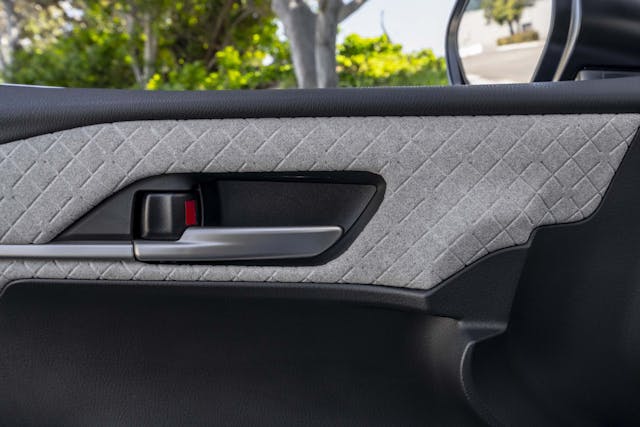
The cabin now features redesigned, more comfortable front seats as well as a new trim design that, on the XLE, makes use of a textured knit material that Toyota calls “Dinamica.” Its application on the dashboard and door cards provides a premium feel, although it still falls a touch short of the Accord’s living quarters.
Although the Accord Hybrid is nearly an inch wider than the Camry, the latter still feels like it makes better use of its space. The past two generations of Camry, in particular, have felt wide from behind the wheel, but in a good way. This new one continues that trend. Second-row seating is as lavish as in the front row, which is great considering the likelihood that many new Camrys end up as taxis or Ubers.
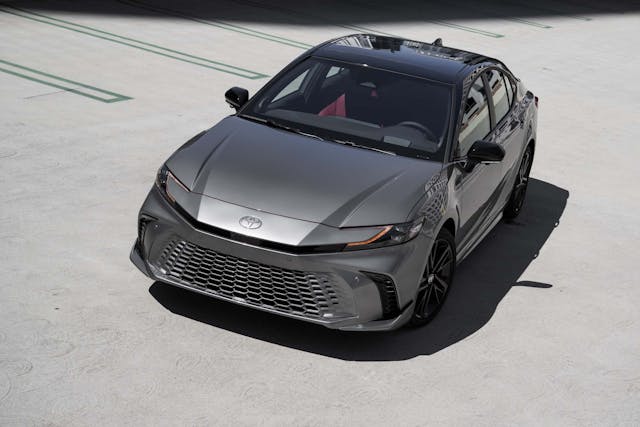
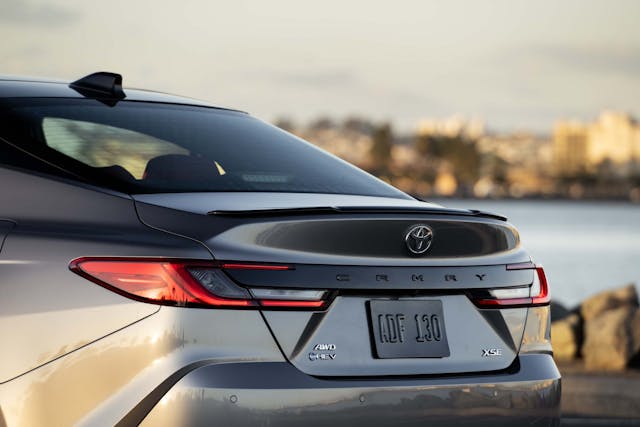

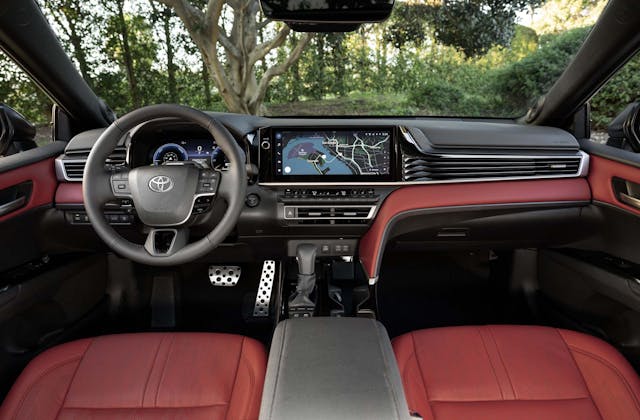
For those Camrys not destined for the ride-share realm, the XSE grade might entice a few buyers with its more athletic presence. The XSE gets unique color-matched mesh for its lower front fascia, as well as a lower “splitter” and rear bumper treatment. It also gets a racy red leather interior, which I’d bet will be this car’s most divisive feature.

The athleticism extends beyond the skin, too. The Camry SE and XSE also get unique suspension tuning with a larger front roll bar and unique dampers for better handling. We threw an XSE AWD around some winding roads just north of the Mexico border and found the car to be rather playful, if you’re willing to wrestle with it. For the 40 future Camry XSE owners who attempt to hustle their car, rejoice: It’s more fun than expected.
But sticking within the Camry’s core competency feels like the better move, which is why the Camry XLE gets our nod. The surprisingly fun interior (which still features plenty of buttons and knobs!) paired with a driving experience that asks nothing of you, even over several hundred miles, was a reminder of why this nameplate remains top of the pile, even if it is a shrinking one.
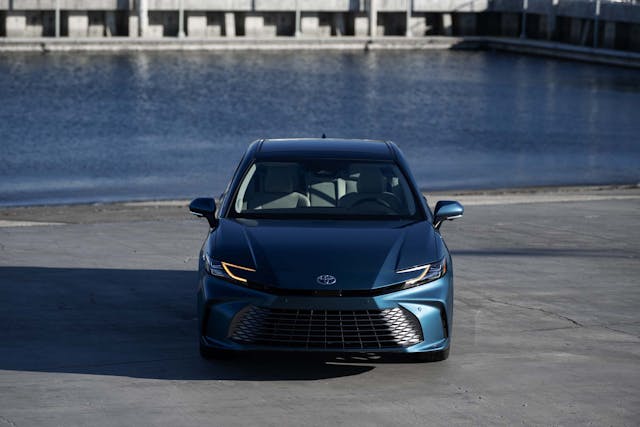
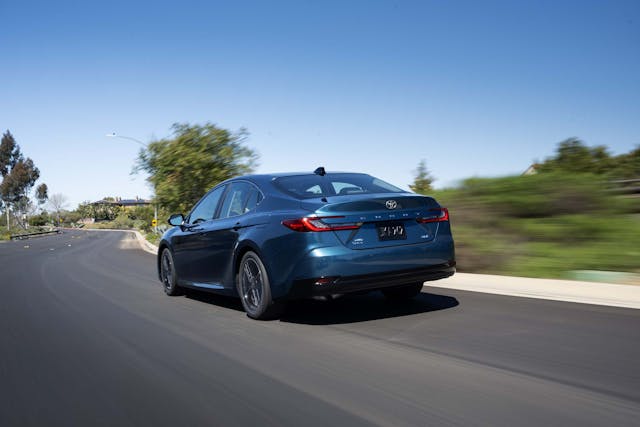

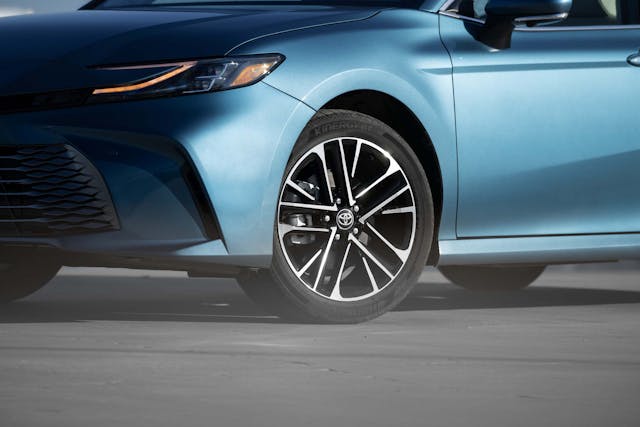

As I was preparing to write this review, I talked with executive editor Eric Weiner, who had recently spent time in the Accord Hybrid. We were comparing notes when he hit me with this line: “The Camry just sort of does everything well.”
Couldn’t have said it better myself.
2025 Toyota Camry XLE AWD
Price: $36,020/$40,780 (Base/As-Tested)
Highs: Jack of most trades, master of mile-munching. Nearly imperceptible hybrid drivetrain, as it should be. “Fun” and “interior” are not words we’d normally pair for a Camry, but the new one embraces the combination.
Lows: Free-breathing four-cylinder can still be drony if you’re listening hard. Your loud friend will probably knock you for buying something “boring.”
Summary: Sometimes it’s fine to let your sensible side win. The Camry won’t let you down, kind of ever. This new one takes a great foundation and builds upon it to make something even better.
***
Check out the Hagerty Media homepage so you don’t miss a single story, or better yet, bookmark it. To get our best stories delivered right to your inbox, subscribe to our newsletters.
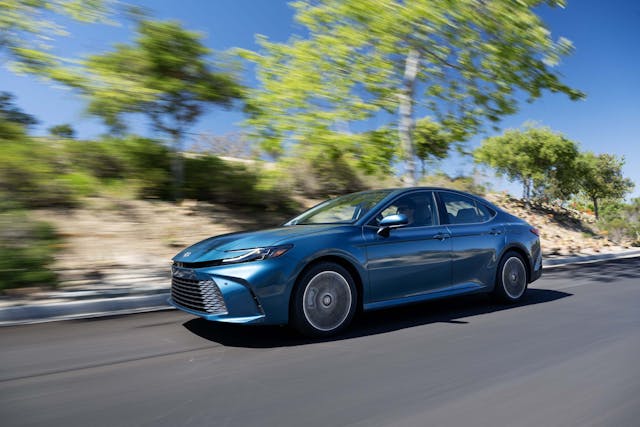


If I was still on the road as Sales Engineer this would be my car. See lots of ‘peddlers’ in hybrid Camrys. There’s it’s sister–an 07 ES350 in our fleet for a couple of years that we bought well maintained with 140K. Feels like it will last forever. Camry has the same bones. I learned Kaisen and SPC in the 90’s and our US customers in the 90’s (GE particularly) demanded its use. US manufacturers dropped these quality systems (correct me if I am wrong) when manufacturing suppliers (I was in metalcasting) went to China early 00’s. It is obvious it has been in the culture at Toyota-now for over 40 years and shows in their products.
I always find it funny how people go on about Toyota mileage. Yes a good car but most others are similar.
In WV nothing is close. You may drive an hour to get to a WalMart or Mc Donalds. Many drive to work an hour or more one way. It is a way of life.
But down there you will see many cars with 200-300-500K miles.
My wifes aunt rolls up 300K miles on GM products on a regular basis. In her case she changes oil and that is about it. No cam belt changes or any other things than brakes and tires. Rust is not too bad there as the weather is not as bad as in the rust belt.
As for truck down there they keep them on the road for ever. Now they may take more beating off road on farms and hunting.
I have a 21 Camry TRD and I lament the loss of that V6 model within the refreshed Camry lineup. Great car; to me it represents pure, peak sedan. It falls short of the true sports sedan standard but I love it all the same. I get why the TRD is gone, simplifying the lineup and aiming it squarely at the more traditional idea of a Camry. If they later come out with a new hybrid TRD that is more powerful, has traditional transmission instead of CVT, has AWD as standard and retains all the handling/ride/braking upgrades of my 21, I will be tempted to take a peek. But it would be very hard to part with my non-electrified non-turboed non-CVT bomb-proof V6 sedan.
I fully expect a TRD version of the new Camry with the Hybrid Max powertrain, and it will be impressive. But you always got to wait a year or two after introduction for the something like that to show up.
I too will miss the V6 but I don’t know about peak sedan. I would say the V8 powered RWD Lexus IS 500 is Toyota’s current peak sedan. For the moment you can still get a V6 if you want FWD by getting an ES 350 till it gets refreshed and likely loses the V6.
About a month ago, I sat in a IS 350 F Sport that was on the showroom floor. Unacceptably cramped in there; so the IS 500 is out too. Not sure why it is noticeably much tighter than the Camry but I just couldn’t live with that. This is a shame because you’re right Gary, I’d love to have that V8. I was in the dealer to look at a GS-F that happened to come in, which I drove. Neat car. But, and I know this will be heresy to some, it just didn’t feel better enough or faster enough than my Camry. I passed on it. I have not sat in an ES but now that you’ve suggested it, maybe I will. At least you can get an F Sport Design trim on those that makes the exterior a little less coma inducing. The styling of my TRD isn’t for everyone but I love it.
My son has a 2023 Camry SE hybrid, my father has a 2013 Prius, and we have a 2022 RAV4 SE hybrid. Toyota hybrids are exceptional, and I was a straight-arrow Mopar owner until recently.
Anyone else think a sleek wagon version would be cool?
Agree!!
That lace skirt hanging off the front grill is ridiculous. Why is everybody going for that trend? Yuck.
That front end treatment is a deal breaker for me. Too bad for Toyota. Otherwise lots of appeal except for the way over-complicated 3 motor plus gas engine powertrain. If I had to buy a Camry it would be a non-hybrid FWD.
YEP!! Every Toyota product has that stupid looking fish mouth treatment in some form. Even the trucks. Good cars? Yes, but surely they could SOMETHING different on the front. The rest of the car looks swoopy & cool.
I’m waiting for my 04 Solara V6 to die before moving to a hybrid. 375k miles and running great.
Toyota’s are reliable as can be, few will argue that fact. But with ALL new cars while the basic drivetrain may go for 200-300k, what about all those electronics? Chips, relays, circuit boards, cameras, sensors, modules, etc., etc…….what the hell is going to happen with all that stuff in 10, 20 years? I’ve never had a computer, or tablet, or phone last that long, and they’re not sitting in a car outside in the elements. I trust the mechanics, it’s the electronics that worry me. Can we get lifetime warranties on electronics?? I love my Camry, but the tire pressure sensors and head unit have already gone south, and those electronics are archaic compared to what they toss in cars now.
I understand your concern. The topic of aging electronics has come up here more than once in the past. And I do believe that concern is due. If it helps knowing, now in its infancy are businesses specializing in repair of aging electronics, including automotive electronics such as those in dashboards. Check out:
https://www.upfix.com/
I’d like to point out that I believe Toyota installs a high-grade of electronics in their vehicles, and I have more to say about why I think that.
From real life experience, we had bought a brand-new top-of-the-line 2007 Chevrolet Aveo. After six years and less than seventy thousand miles I’d had enough of things breaking on that car, as the things that broke, we’re always poorly or cheaply made. And GM’s goodwill repairs for out of warrantee cars had become quite lame. The last thing to go was the digital odometer display. GM made us pay for half of the costs for replacing it. That bothered me terribly because it seems to me no matter how badly someone treats a car, an odometer display just shouldn’t break. And I felt that GM should have absorbed the entire cost. We take excellent care of our cars and being older we drive sensibly. Our Aveo still looked great and ran great too, but I was very concerned in having to pay for an expensive repair since learning that GM doesn’t stand by their customers.
And after years and years of be loyal to GM, I’d finally had enough.
We then found a reputable Toyota dealership and bought a brand-new 2013 Prius C/Level 2.
I made that purchase in blind faith, completely based on what I’d read and heard people say about Toyota’s over the years.
Our Prius C will be eleven years old this fall, with under seventy-thousand-miles. And it’s never broken once.
Maintenance only, with best fluids from AMSOIL and Shell V-Power gasoline.
However, if I wanted to be picayune about it, the truth is I had two things break, as follows:
In year seven, the right taillight bulb burned out. And in year nine, the left taillight bulb burned out. That’s it. That’s what’s broken on our Toyota Prius C. It’s been the best car we ever had and the best that we’ve ever known of.
Well said! I think it would be interesting for Hagerty to do a feature on the ultra-complicated electronics that are now a major part of all new and recent automobiles. Most of us that are used to wrenching on our own cars will be lost. Imagine when the only way to keep your car running yourself is to have a degree in IT? The older “simpler” cars won’t be around forever, so this new generation of computerized plastic will be the next “classics”. Almost glad I’ll be dead…
Sure, there are going to be some duds, but it seems like electronics are amongst the most reliable things on the older cars I have owned. Case in point: I just drove my 1985 Corvette yesterday, and that thing has a first generation digital dash, now about 40 years old, and it still works perfectly. The digital radio still works too, and the digital clock still keeps time well.
The only electronic thing I can think of that has failed was the side blind zone sensor on an old Cadillac. I could probably get one from a wrecker if I tried.
Just rented a lower trim model Camry this last week. It is competent, but does not leave me wanting to choose Camry again. The exterior mix of grotesque and non-functional front and rear design elements are juvenile and almost embarrassing. The basic standard issue 4 cylinder and automatic FWD powertrain are effective but engine noise is intrusive on acceleration. Sorry Toyota, I would not be willing to choose Camry when there are other equally competent options available, like the Honda Accord.